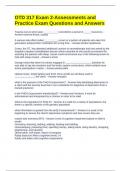OTD 317 Exam 2-Assessments and
Practice Exam Questions and Answers
Trauma occurs when a/an _____ _____ overwhelms a person's _____ resources. -
Answer-external threat, coping
A serious side effect called __________ occurs in a portion of patients who take first
generation antipsychotic medication for a long time. - Answer-tardive dyskinesia
Susan, the OT, has attended additional courses on aromatherapy and was asked by the
hospital's inpatient rehabilitation director which essential oil she would recommend for
assisting the patients with sleep. Susan could recommend any of the following known to
help with sleep except: - Answer-Lemon
George noted that when his clients engaged in ___________________ activities he
was able to tap into emotions and the limbic system connections, which yielded more
active participation in tasks. - Answer-pleasurable
Upbeat music, bright lighting and fresh citrus smells are all ideas used to
_______________ the client. - Answer-energize
what is the purpose of the PHQ-9 assessment? - Answer-help identifying depression in
a client and the severity level but is not a substitute for diagnosis of depression from a
trained practioner
is the PHQ-9 assessment standardized? - Answer-yes! however, it must be
administered and interpreted by a clinician in order to be valid
What is the population for PHQ-9? - Answer-it is valid for a variety of populations, but
there's a specific mention of the geriatric population
what information is gained from the pHQ-9 assessment? - Answer-it is used in the
beginning to assess the client's depressive symptoms and how severe they are
routine task inventory (RTI) - Answer-Level of cognitive impairment based on Allen's
model
Grooming, dressing, bathing, walking, feeding and toileting
Housekeeping, preparing food, spending money, taking meds, doing laundry, shopping,
telephoning, and traveling
Observation, self-report, report of caregiver
Rated based on Allen's cognitive levels 1-6
Adults and elders with cognitive impairments
, what are the 4 areas of occupation for the RTI? - Answer-ADL, IADL, communication,
and work readiness
what is the information gained from the RTI? - Answer-gain a better understanding of
the client's functional cognition strengths and deficits related to participation and
engagement in daily occupations
what is the population for RTI? - Answer-cognitive disabilities: stroke, schizophrenia,
depression, dementia
what setting is RTI not recommended for? - Answer-acute, ICE, or peds
it is used often in mental health settings, SNF, home settings, and community programs
for elderly
is RTI standardized? - Answer-yes! subjective and objective observation, interview, then
score determined on a 6 pt scale
is the RTI an activity analysis or a functional evaluation? - Answer-both
who can complete an RTI? - Answer-client, caregiver, and therapist
occupational self-assessment (OSA) - Answer-Clients rate their occupational
competence for engaging in 21 everyday activities and the importance of those
activities. Allows clients to set priorities for change. Used to generate goals and assess
outcomes or change in competence and values
purpose of OSA - Answer-facilitates client-centered therapy and assists clients and OT
to identify valued occupations that could be improved in performance
format and standardization of OSA - Answer-paper form or PDF, it costs money and is
NOT standardized, good outcome measure, 15-30 min
what is the population and setting for the OSA - Answer-adults, older adults,
musculoskeletal disorders, community setting
inpatient, outpatient, SNF, community and group settings
pediatric version of OSA - Answer-COSA for those who are 8-17 years old
what is the OSA based off of? - Answer-the MOHO model
OCAIRS (Occupational Circumstances Assessment Interview and Rating Scale)
purpose - Answer-.analyze client's perception of occupational performance and
participation in interviewing
measure and quantify occupational performance




